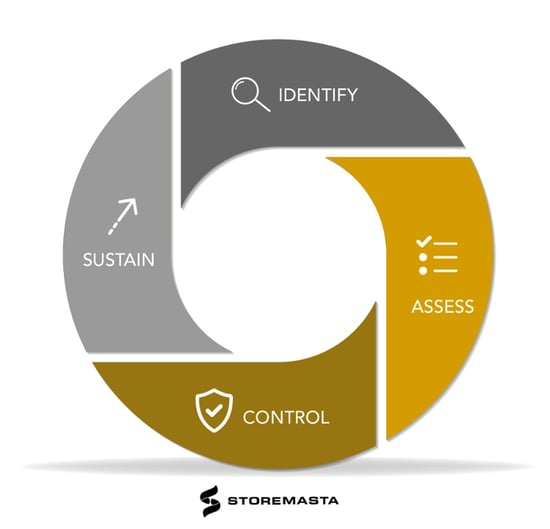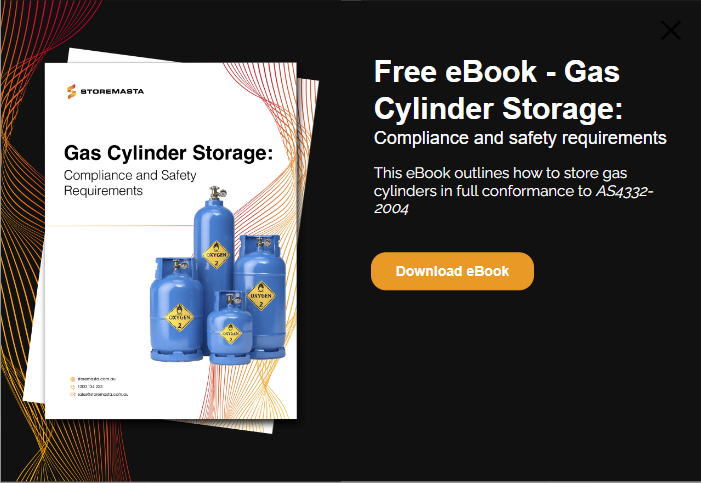Compressed gases stored under pressure in cylinders present a complex range of hazards. Therefore, a consistent and reliable risk management approach is necessary to ensure that all the hazards are carefully assessed and controlled. This post explains to use our simple 4-Step Risk Management Methodology to control the hazards associated with gas cylinders in your workplace.
Gas Cylinder Hazards
The hazards that surround gas cylinders have different layers of complexities.

To ensure safety in the workplace, you need to be aware of the hazards associated with your gases.
First, you have the chemical hazards associated with that particular division or class of dangerous goods.
The properties of the gases are detailed in the Safety Data Sheet and may include the ability to cause adverse health effects, such as breathing problems, chemical burns, toxic gas poisoning or fatalities due to corrosive gas inhalation.
The second layer is the physical nature of the compressed gas cylinder. Their tall and slim design means they can be easily knocked over and broken. This could result in a gas leak, which could ignite, explode or replace the oxygen content in the air, creating an asphyxiation hazard. In addition to this hazard, another layer exists. As the metal cylinders are heavy and awkward to move, they can potentially cause physical injuries from incorrect handling. They may also create serious impact injuries if there is an uncontrolled release of pressurised gas.
Using a Risk Management Methodology
For these reasons, our Dangerous Goods Storage Consultants at Storemasta use a Risk Management Methodology to ensure that every risk associated with the compressed gases is identified and controlled.

Our methodology has 4 easy to follow steps, but for this example, we’ll be focusing on Step 3: CONTROL.
In summary, our 4-Step Risk Management Methodology looks like this:
- STEP 1 IDENTIFY - Physically identify every gas cylinder at your worksite; mark locations on a sitemap; take note of gas types, cylinder types, quantities held, empties; use the Safety Data Sheets (SDS) to identify the health hazards and physiochemical hazards.
- STEP 2 ASSESS - Consider how the gases and cylinders are received, handled and stored; identify all possible dangerous incidents that could occur onsite (fires, explosions, gas cloud, toxic gas exposure); assign each dangerous incident a risk score out of 10.
- STEP 3 CONTROL - Prioritise the hazards with the highest risk score; use the Hierarchy of Controls to consider the best control measures to either eliminate or reduce the harm associated with each hazard; implement each control measure.
- STEP 4 SUSTAIN - Conduct another risk assessment to ensure no new hazards have been introduced; review your risk assessment and control measures periodically to sustain WHS compliance and safety at your workplace.
IMPORTANT: The methodology is only effective if all 4 essential steps are completed in order.
Understanding the Hierarchy of Controls
Once you’ve identified all the gas cylinder hazards at your worksite and given each a risk score out of 10. Now you need to control each of the hazards, starting with those that have the highest risk scores.
Storemasta use an industry standard practice called the Hierarchy of Controls to determine which control measures will be the most effective (and the most feasible to implement). It has five levels which should all be applied to each hazard.

Risk Management with LPG Example
Let’s see how the Hierarchy works by highlighting an example that you may find in your own workplace. In this situation, we’ll imagine that you’re using forklifts that are powered by LPG cylinders in your packaging warehouse.
REMEMBER: LPG is a highly flammable gas and an asphyxiant. LP gas can present cold burns if it makes contact with the skin. This flammable gas can make staff sick if they are breathing it in after an accidental release.
Level 1: Elimination
The most effective control measure is to eliminate the hazard completely. Make a list of all the ways you could completely eliminate LPG onsite, such as changing to electric pallet trucks or outsourcing the packaging offsite.
NOTE: Not every possibility is feasible, but it’s important to apply each level to your hazards so you can make a well-informed decision.
Level 2: Substitution
Substitution is the next level in the Hierarchy of Controls if the hazard can’t be fully eliminated. Therefore, if you determine that you can’t eliminate the flammable gas hazard, could you replace the LPG with something less harmful? As part of the substitution stage, you may wish to consider different types of equipment that could carry out the same task. This could include options such as diesel-powered forklifts instead of those that depend on LP gas.
REMEMBER: When you substitute a hazard, you must then re-assess the situation to see if a new hazard has been introduced.
Level 3: Engineering Controls
Consider how you could re-design the workplace to reduce the amount of employees who are exposed to the LPG hazards? Could you isolate LPG cylinder stores and forklift refueling areas? Engineering controls are an essential part of the risk management process, and can involve a vast range of solutions including compliant gas cylinder storage and handling equipment. By reducing the likelihood of an accident or incident through the implementation of safe handling and storage, your engineering controls are an effective way to manage gas cylinder hazards.
Level 4: Administrative Controls
Level 4 administrative controls cover operating procedures and staff training. When thinking about the implementation of these administrative controls, consider what safe operating procedures could be developed to reduce the likelihood of an accident with the LPG cylinders? Keeping unauthorised personnel away from LPG stores and banning ignition sources like personal electronics are just two examples of administrative controls that would reduce gas cylinder hazards.
Level 5: Personal Protective equipment
PPE is the least effective control measure and should only be used in conjunction with other control measures. In this instance, you could make it a requirement for staff changing cylinders to wear protective overalls and insulated gloves.
Implementing Control Measures
Once you’ve considered every level in the Hierarchy of Controls, now make your decision based on what will be the most effective.
In our LPG example, Level 1 is impossible because we can’t shut down the warehouse to outsource the task and electric pallet trucks don’t have enough lift range.
Level 2 is also impractical because it would be expensive to change over the fuel tanks and a new hazard (diesel fuel) is now introduced.
Therefore, the most appropriate measures would be a combination of Level 3, 4 and 5. This would involve isolating cylinder stores and ensuring that staff receive thorough and regular training. Plus, ensuring that all handling staff wear protective overalls and insulated gloves.
Engineering Controls for Gas Cylinders
There are a wide range of engineering controls that can bolster your onsite safety. From gas cylinder cages to gas bottle trolleys, our gas cylinder controls are made in full conformance with Australian Standards so you can control hazards at your site.
Examples of gas storage options:
- Aerosol cages
- LPG cages
- Industrial gas stores
- Gas trolleys
Importance of Sustaining Compliance
As you work through and implement control measures for each gas cylinder hazard, don’t forget to follow through the entire risk management methodology. You’ll need to complete STEP 4 SUSTAIN to ensure that no new gas cylinder or chemical hazards have been introduced and compliance is sustained.
The 4-Step Risk Management Methodology is not a once-off task. In fact, the only way to ensure ongoing safety and compliance is to treat the methodology as a circular process that is continually working to identify, assess, control and sustain onsite safety.
REMEMBER: You can learn more about risk assessments and controls by reading our blog, Compressed Gases in Cylinders: When Do You Need a Risk Assessment?
Control Your Gas Cylinder Hazard
Whether you’re using flammable gas cylinders, oxidizing gas cylinders or corrosive gases in your workplace, there are specific hazards that need to be controlled to ensure a safe working environment. Incidents such as asphyxiation, fire or impact damage can quickly occur if your gas cylinders (and empty cylinders) aren’t handled or stored in the correct way. If you’d like to know more about using the Storemasta Risk Management Methodology to control the gas cylinder hazards at your worksite, you can get a copy of our eBook. Gas Cylinder Storage: Compliance and Safety Requirements highlights some real-world examples and case studies to clearly demonstrate our in-house risk management methodology. Grab your copy today and reduce the risks associated with compressed gases in cylinders.

Living life by the 4 C’s of marketing – communication, coffee, compliance… and more coffee – Leisa Andersen is Storemasta’s Content Marketing Manager. When she’s not writing, you’ll find her enjoying all the good things in life, including shopping, travel and gluten free donuts.
